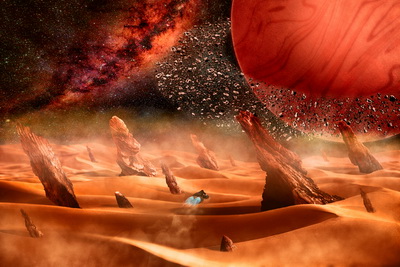
The Extraterrestrial Delima
Some say that we are the only intelligent life in the universe, but others tend to differ, and if you include the calculations in our article Life in Outer Space, a Mathematical Approach, there is a good probability that they are correct.
But we are probably the only planet that has species that look exactly like us. The aliens would have to live under the same environmental conditions that exist on this planet. If there is just a .001% difference on their planet as there is on Earth, our alien friends could look much different.
That’s because all living things on Earth have physically adapted to this planet’s environment; such as adapting to the atmosphere, which is 78 percent nitrogen and 21 percent oxygen, as well as adjusting to the planet’s range of temperatures and seasons. The result is that we are a species that consists of two ears, two eyes, two lungs, and a bunch of other organs that keep us alive through these earthly conditions.
So the chances are very high that there isn’t a planet exactly like Earth, but some exoplanets in the habitable zone might come pretty close. Instead of saying we may be the only intelligent life in outer space, it may be more prudent to say we may be the only intelligent life that looks like us in outer space.
An Exoplanet With a Slight Change

Suppose that there is a planet revolving around a star 100 light-years from Earth. We’ll call this planet Exo, but on this planet, there is a slight change in its atmosphere, namely, its oxygen level is 90 percent nitrogen and 10 percent oxygen.
On Earth, it is 78 percent nitrogen and 21 percent oxygen. So if aliens from Exo would happen to land on Earth, their lungs would need to be 11% larger than ours, in order to compensate for the lower oxygen level that their bodies are naturally accustomed to on their planet.
Now suppose that Exo is 20% further from its star than the Earth is from our sun (Earth is 93,000,000 miles away). That would mean that it would be 18.6 million miles further away from its star as compared to Earth’s proximity to our sun. Everything would be darker on Exo and cooler as well.
Our hypothetical species would require larger eyes than us to compensate for the lack of sunlight. Needless to say, their winters will be colder, so those living in a Siberian type of weather on Exo would have thicker skin than their counterparts on the warmer side of the planet (warmer relative to that planet’s environment, not ours).

In this case, we would be looking at beings with larger chests, bulging eyes, and thick skin as compared to us. So they would need some type of protective gear or suits in order to compensate for the increased oxygen and lighter atmosphere. If they don’t have this protection, they would be consuming too much oxygen and risk having severe eye conditions, possibly even going blind if they are outside too long.
So when you see sci-fi movies that show extraterrestrial beings walking on our planet without some sort of protection, it would not be an accurate portrayal.
What About Gravity on Exo?
The amount of gravity would be determined by the size (mass) of the planet, so if Exo is 10% larger than Earth, then the creatures living there would probably have heavier and stronger legs. Their legs may bulge out more or they may be longer than what we humans would look like, or maybe they have three or four legs. Not a far thought since thousands of species on this planet also have four legs.
For a more in-depth look at how aliens may evolve, take a look at this video below.
Time is Everything
We have discussed how the physical characteristics of alien life might look on a habitable planet similar to life here on Earth. But what about their evolution process? Did it take the same amount of time for these aliens to evolve as we did? In other words, humanoid life on Earth has been estimated period and 200 million years ago, but does that mean that creatures on other planets began their evolution process within the same time period as we did?
What Year Is It?
We first have to consider that a year on Exo would probably be different than our years. If Exo is 10% further away from its sun, then it will take longer for the planet to revolve around it, a 365-day revolution (if days are the same there) won’t work. We estimate that it takes 400 Exo days for it to complete one of its years.
Are We the Most Intelligent of All Species in the Universe? Watch What You Say!
The above scenario is based upon a similar period it would take for beings like us to evolve on a different planet. Chances are that this would not be the case.
What if Exo was formed 500 thousand years later than it did on Earth? Well, that would mean that they would have evolved only to what we could equate to Neanderthals. Now that type of communication doesn’t look promising.
But what hat if Exo was formed 500 thousand years earlier than here on Earth? That would mean that Exo’s inhabitants would have hundreds of thousands of years more time to evolve than we humans have on this planet.
If their evolution started that much earlier then we could conclude that they are mentally superior to us. If that is the case and they do (or some believe that they have already) come to Earth, will they be friendly?
We Come in Peace, Maybe.
Scientists are contemplating a new communication with ET via signals to be sent from huge telescopes here on Earth. It will be called the Beacon in the Galaxy and will contain mathematical, physical, and biological representations of earthlings, as well as our location in the Milky Way galaxy. But if aliens do find this and they equate to the scenario of advancement over us, is this a smart move? Only time will tell!
